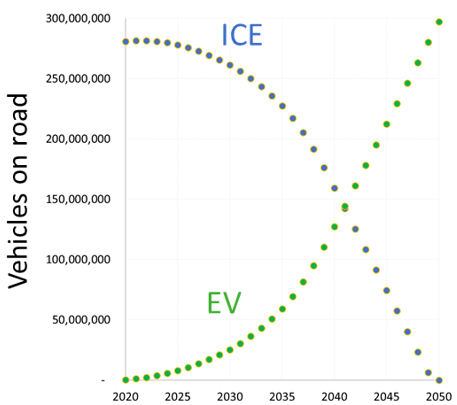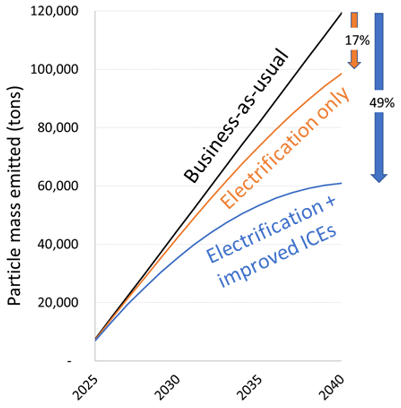Do we need reductions in tailpipe particulate emissions, given that cars will be electric ?
This is a very simple calculation to show that it is imprudent to ignore improving internal combustion engines under the pretext of full electrification. The US is taken as an example, but the exercise is easily done for other markets.
(Note that unlike the US, vehicle sales are actually expected to grow in China, making the case for improving ICEs even stronger in that region).
Assumption : 100% EV (new) sales by 2040
Let’s assume that all new vehicles sold in the US are full battery electric vehicles (BEVs) by 2040 with zero tailpipe emissions.
The figure here is an assumption on the growth of the market share of BEVs, starting with ~ 2% today to 100% in 2040.

Fleet powertrain evolution
Today, there are ~ 280 million internal combustion engine (ICE) powered cars in the US. And 17 million new cars are sold each year. The ICE vehicles will be replaced with electrics with time, but it will be a long time before we see the last of the ICEs being sent to the scrap yard. The figure here shows the evolution, it is seen that even in 2040, there will be ~ 150 million ICE vehicles on the road.

How does all of this impact particulate emissions ?
Assumption: Cars emit 2 mg/mile of particulates. (This is a reasonable assumption – the EPA limit is 3 mg/mile today)
- In the business-as-usual scenario with no electrification, the cumulative PM emissions are ~ 120,000 tons by 2040.
- With electrification (100% EVs by 2040), these emissions are reduced by 17%. The existing ICE fleet continues to emit particulates, hence the small reduction.
- Now assume that ICEs get cleaner and emit 90% lower PM – this can be the case with improved injectors, cleaner fuels, and the addition of particulate filters. The reduction in cumulative PM is much more substantial : almost 50% of the 120,000 tons of PM are prohibited from entering the atmosphere.

So what’s the point ?
At 85 kWh battery pack per vehicle, converting all 17 million vehicles to electrics will require ~ 1.5 TWh of batteries each year for the US, light-duty sector alone – Europe, China, India and other major markets will also compete for battery resources, as will the heavy-duty sector. So assuming that it could take up to 2040 for a complete shift to electrics is not unreasonable.
Given that the lifetime of vehicles is ~ 12 years, it is then expected that those ICEs sold up to 2040 will remain on the road for a decade further and will continue to emit particulates.
It is clear that along with electrification, it is important to quickly adopt advanced emissions control technologies on existing ICE vehicles to achieve deep reductions in particulate pollution.
Check out the monthly newsletter covering the latest on sustainable transportation technologies and regulations. Sign up if you like such content.
Like it ? Share it !
Other recent posts
IRENA Renewable Energy Capacity Statistics 2025
![]()
According to the latest report from IRENA, 2024 saw the largest increase in renewable capacity, accounting for 92.5% of overall power additions.
CO2 Emissions Performance of Heavy-Duty Vehicles in Europe – 2022 Results
![]()
The European Commission has published the official 2022 CO2 emission results for heavy-duty vehicles. Many OEMs are ahead of the targets and have gained credits, while others have their work cut out as we approach the 2025 target.
A summary of the SAE 2025 OBD Conference held in Porto, Portugal
![]()
A summary of the SAE 2025 OBD Conference held in Porto, Portugal, provided by MAHLE Powertrain.

